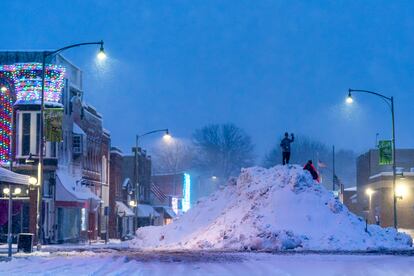New Jersey under a state of emergency as flooding, wind, pummel Northeast
The weather has already affected campaigning for Iowa’s Jan. 15 precinct caucuses, where the snow is expected to be followed by frigid temperatures

A major storm drenched the Northeast and slammed it with fierce winds, knocking out power to hundreds of thousands following a bout of violent weather that struck most of the U.S.
The storm, which started Tuesday night and was moving out Wednesday, washed out roads and took down trees and power lines. Wind gusts reached 45 mph to 55 mph (72 kph to 88 kph) and more windy weather was expected throughout Wednesday.
It followed a day of tornadoes and deadly accidents in the South and blizzards in the Midwest and Northwest.
In New Jersey, where Gov. Phil Murphy declared a state of emergency in advance of the storm, many streets and roads were flooded and rivers were rising after some areas got up to 3 inches (7.6 centimeters) of rain since Tuesday night. The storm knocked out service on some train lines in New York City and flooded a highway in the Bronx, upending thousands of commuters on Wednesday morning.
Lou DeFazio, 65, of Manville, New Jersey, lives steps away from the Millstone River that flooded disastrously in 2021 after the remnants of Ida slammed into the state and swerved riverbanks. He said the river was expected to crest later Wednesday. “It’s getting worse and worse,” he said.
In Maine, Gov. Janet Mills delayed the opening of all state offices until noon Wednesday due to the storm, which began as snow and later turned into rain in parts of New England. Heavy snow was hitting parts of northern Vermont, New Hampshire and Maine on Wednesday morning.
As high tide neared closer on Long Island on Wednesday morning, parts of the southern shore were already inundated by coastal flooding. In Nassau County, video showed cars sloshing through water that had collected on the streets of Freeport. Further east, near the Hamptons, the National Weather Service reported major flooding out of Shinnecock Bay. Several schools across Long Island said they were either canceling or delaying classes as a result of the storm.
The wild weather came as portions of the Northeast were still digging out from a nor’easter that dumped more than a foot of snow in some areas over the weekend.
In Danbury, Connecticut, officials said the snow that melted in the overnight rain had overwhelmed the city’s drainage capacity, leaving a dozen intersections flooded. At least one motorist was rescued from a vehicle.
Powerful winds gusted to 95 mph (153 kph) at Maine’s Isle au Haut, an island in Penobscot Bay, and to 83 mph (134 kph) off the coast of Rye New, Hampshire, said Jon Palmer from the National Weather Service in Gray, Maine.
Tens of thousands of homes and businesses were in the dark, mostly in coastal areas that were lashed by wind and rain. Farther inland, heavy wet snow blanketed the region.
On Tuesday, the same weather system brought heavy rain, hail and at least three reported tornadoes to the South before moving eastward.
Rain and high winds extended into the nation’s capital Tuesday night, forcing Vice President Kamala Harris’ aircraft to divert from Joint Base Andrews to Dulles International Airport near Washington when it encountered wind shear — a sudden shift in wind direction or speed.
Several deaths have been blamed on the storms. An 81-year-old woman in Alabama was killed when her mobile home was tossed from its foundation by a suspected tornado. Another person died in North Carolina after a suspected tornado struck a mobile home park. A man died south of Atlanta when a tree fell on his car. In the Midwest, slushy highways led to the deaths of a driver in Wisconsin and another in Michigan following collisions.
The National Weather Service office in Tallahassee planned to send out three tornado survey teams on Wednesday to examine suspected tornado damage in Walton, Bay and Jackson counties in Florida, and two more on Thursday to look at Houston County, Alabama, and Calhoun County, Georgia.
Roofs were blown off homes, furniture, fences and debris were strewn about during the height of the storm in the South.
Many areas of Florida remained under flood watches, warnings and advisories early Wednesday amid concerns that streams and rivers were topping their banks. Gov. Ron DeSantis, who gave his State of the State address Tuesday as tornado warnings were active outside the Capitol, issued an executive order to include 49 counties in North Florida under a state of emergency.
Another storm that began Monday buried cities across the Midwest in snow, stranding people on highways. Some areas saw up to a foot (30 centimeters) of snow on Monday, including Kansas, eastern Nebraska and South Dakota, western Iowa, and southwestern Minnesota.
In Des Moines, Iowa, Laura Burianov had nearly finished shoveling her driveway Tuesday morning. But with snow still falling, she acknowledged she likely would have to shovel again later in the day.
“It’s going to get harder. I shoveled last night and you can’t really tell, but I can pretend that three less inches makes a difference,” she said.
Madison, Wisconsin, was under a winter storm warning until early Wednesday, with as much as 9 inches (23 centimeters) of snow and 40 mph (64 kph) winds on tap.
The weather has already affected campaigning for Iowa’s Jan. 15 precinct caucuses, where the snow is expected to be followed by frigid temperatures that could drift below zero degrees (minus 18 Celsius).
Forecasters warned snow-struck regions of the Midwest and the Great Plains that temperatures could plunge dangerously low because of wind chill, dipping to around minus 20 (29 Celsius) and even far lower in Chicago, Kansas City and some areas of Montana.
In the Pacific Northwest, a blizzard pounded Washington and Oregon mountains on Tuesday, knocking out power and prompting the closure of highways and ski resorts.
At one point, some 150,000 customers in those states were without electricity, although that was down to under 20,000 by Wednesday morning.
The storms with their potent mix of snow, rain, hail and wind played havoc with power lines in other states. Nearly 500,000 customers were without power in Maine, Vermont, New York, Pennsylvania, New Jersey, North Carolina and Virginia, according to the website poweroutage.us.
Sign up for our weekly newsletter to get more English-language news coverage from EL PAÍS USA Edition
Tu suscripción se está usando en otro dispositivo
¿Quieres añadir otro usuario a tu suscripción?
Si continúas leyendo en este dispositivo, no se podrá leer en el otro.
FlechaTu suscripción se está usando en otro dispositivo y solo puedes acceder a EL PAÍS desde un dispositivo a la vez.
Si quieres compartir tu cuenta, cambia tu suscripción a la modalidad Premium, así podrás añadir otro usuario. Cada uno accederá con su propia cuenta de email, lo que os permitirá personalizar vuestra experiencia en EL PAÍS.
¿Tienes una suscripción de empresa? Accede aquí para contratar más cuentas.
En el caso de no saber quién está usando tu cuenta, te recomendamos cambiar tu contraseña aquí.
Si decides continuar compartiendo tu cuenta, este mensaje se mostrará en tu dispositivo y en el de la otra persona que está usando tu cuenta de forma indefinida, afectando a tu experiencia de lectura. Puedes consultar aquí los términos y condiciones de la suscripción digital.
More information
Archived In
Últimas noticias
Most viewed
- Reinhard Genzel, Nobel laureate in physics: ‘One-minute videos will never give you the truth’
- Oona Chaplin: ‘I told James Cameron that I was living in a treehouse and starting a permaculture project with a friend’
- Pablo Escobar’s hippos: A serious environmental problem, 40 years on
- Why we lost the habit of sleeping in two segments and how that changed our sense of time
- Charles Dubouloz, mountaineering star, retires at 36 with a farewell tour inspired by Walter Bonatti









































